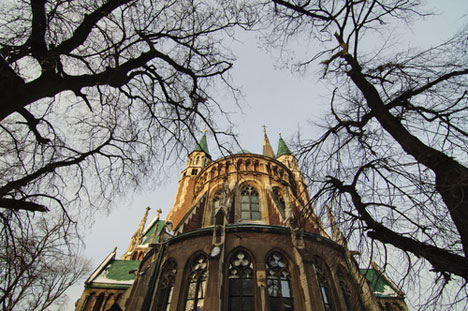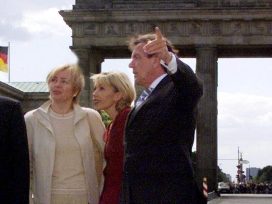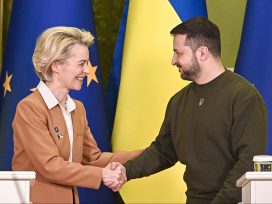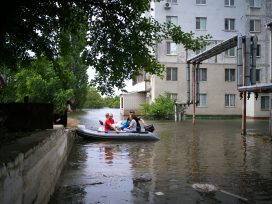A church caught between?
When Pope Francis and Patriarch Kirill met in Havana, for one part of the Catholic Church the past seemed to be repeating itself, writes Katherine Younger. In the nineteenth century, the Ukrainian Greek Catholic Church found itself in the middle of both diplomatic negotiations and ideological clashes between the Vatican and Russia – and it is again today.
Much has been made of the meeting between Pope Francis and Patriarch Kirill in Havana on 12 February 2016: both sides have hailed it a historic event, the first meeting between the heads of the Catholic and Russian Orthodox churches since the Great Schism of 1054. Undoubtedly a major development, it is tempting to look at this meeting as an optimistic sign for the future of ecumenical cooperation between eastern and western Christianity. Nonetheless, we must not overlook the geopolitical stakes that have always been and continue to be bound up with Vatican-Russian Orthodox relations: there is a long history of negotiation, appeasement, manipulation and tense coexistence between the two sides, despite their significant doctrinal differences.
After the Havana meeting between Kirill and Francis, Metropolitan Hilarion Alfeyev, the chairman of the Russian Orthodox Church’s department of external relations, released a statement confirming that, despite both men’s expressed desire for Christian unity, one of the points of contention between the two sides was the Greek Catholic Church. This was also alluded to in a press conference that Alfeyev gave in the lead-up to the Havana meeting, in which he deemed the Greek Catholic Church a “never-healing bleeding wound that prevents the full normalization of relations between the two Churches”.1

Originally built as the Roman Catholic Church of St. Elizabeth, the Lviv church pictured above serves today as the Greek Catholic Church of Sts. Olha and Elizabeth. Photo: GavranBoris/Shutterstock.com. Source: Shutterstock
As Alfeyev’s statements indicate, the Ukrainian Greek Catholic Church, an Eastern Rite Catholic Church created in 1596 by the Union of Brest, has long been a point of tension between the Catholic Church and the Russian Orthodox Church. As a result of the union, Orthodox bishops within the Polish-Lithuanian Commonwealth accepted papal authority while being allowed to maintain the practices and customs of the Eastern Rite. Adoption of the new confession was not a smooth process, but by the time of the Partitions of Poland in the late eighteenth century, membership in the Uniate Church (as it was then known) amounted to several million individuals, living on the lands of modern-day Belarus and Ukraine. After the partitions, in which the territories where the Uniate Church existed were split between the Russian Empire and the Habsburg monarchy, the fate of the church diverged dramatically.
The Russian government, which saw the church as illegitimate and schismatic, sought to repress it, not infrequently resorting to force. They saw it as little more than a suspicious institution controlled by other powers (particularly the Polish clerical elite). Meanwhile, the Habsburg government recognized it as a potentially useful counterweight to the dominance of the Polish political class in the newly-created province of Galicia, and thus worked to foster its development through clerical education and financial support. It was the Habsburgs who introduced the Greek Catholic moniker; they thought that the parallel to Roman Catholic helped to demonstrate the equality of the two rites.
Confessional diplomacy
Even if the Havana meeting is historic for bringing together the highest levels of Catholicism and Russian Orthodoxy in a religious capacity, there has always been complex interplay between religious and political authority on both sides. After all, the Vatican is simultaneously church and state, and the Russian Orthodox Church’s entanglement with the Russian state has long been noted. In the Russian Empire, the official head of the Russian Orthodox Church was not the patriarch, but rather the tsar himself; the Holy Synod, the highest governing body of the church in the imperial period, was also headed not by the patriarch of the church but by a government official. This meant that interactions between the two sides have always been extremely ambiguous: were they dealing with each other as religious or secular entities?
The recent meeting was hardly the first time that the Greek Catholic Church has found itself at the heart of tensions in the Russian-Vatican diplomatic relationship. One of the most prominent recent examples of this is the so-called Lviv Sobor of 1946, at which a part of the Greek Catholic hierarchy proclaimed the church’s conversion to Orthodoxy under extreme pressure from the Soviet government. At that time, the fundamental ideological antagonism between the Soviet regime and the Vatican meant that the former felt no need to take Vatican feelings into consideration and the latter had no reason to moderate its expressions of outrage. This is in contrast to the present moment, when a reconciliation could be seen by both sides as a positive development. In this sense, the antecedents of the Havana meeting lie not in the twentieth century but in the nineteenth, when two conservative powers stood to benefit from a friendly (or at least not openly confrontational) relationship.
A particularly fruitful point of reference and comparison for the present moment is the 1840s. The decade was ushered in by a dramatic event: in 1839, the Russian government – in collaboration with the Uniate hierarchy, who were driven by a mixture of zeal for the Eastern Rite and the allure of honours and financial gain promised by the Russian government – suppressed the Uniate Church on its territory. This event, referred to officially as a vossoedinenie, or “reunification”, resulted in nearly two million members of the Uniate Church being incorporated (with varying degrees of willingness) into the Russian Orthodox Church. After this, all that remained of the Uniate Church in the Russian Empire was the small, jurisdictionally anomalous diocese of Chelm; its counterpart across the Russian-Habsburg border, the Greek Catholic Church, was now the unquestioned heart of Eastern Rite Catholicism in eastern Europe.
It seems obvious enough that Vatican officials would be outraged by the vossoedinenie – and indeed they were, though the indignation they expressed in their internal correspondence did not translate into a public condemnation of the event until 1842, in Pope Gregory XVI’s allocution Haerentem diu. (He had bemoaned the matter back in 1839, but in a secret consistory rather than a public statement.) Even when a formal statement was issued by the Vatican, blame for the vossoedinenie was placed carefully at the feet not of the Russian government, but of the ex-Uniate archbishops who had acquiesced to their church’s conversion to Orthodoxy. Yet Nicholas I, the tsar at the time, took umbrage nonetheless: he perceived the allocution as outside interference in a strictly internal matter.
Tensions remained high for the next few years, as all formal diplomatic ties between the Russian government and the Vatican were severed. But eventually Nicholas came to believe that reconciliation with the Holy See would be in the imperial family’s best interests: he wanted to arrange a marriage between his daughter Olga and Archduke Stefan of the Austrian royal family. The Habsburgs, as relayed to the Russian ambassador by Prince Metternich, the Austrian chancellor, expressed interest in such a match, but their commitment to Catholicism meant that the marriage could never take place without express approval from the Vatican. (In reality, it appears that they never took the proposal particularly seriously, but rather were manipulating the situation to encourage a Russian-Vatican rapprochement.)
And thus, in what Metternich deemed “one of the most remarkable events of our epoch”, Nicholas proposed a brief stop in Rome during a journey to Italy, to meet face-to-face with Pope Gregory XVI in the hope of finding common ground. In the end, the two leaders met personally on three occasions, followed by extensive negotiations between their subordinates.
When discussions began, the matter of the Uniate Church was prominently featured in the Vatican’s formal list of complaints. But Russian representatives made it clear that they considered the vossoedinenie a voluntary act of the faithful, an internal Russian matter, and, moreover, a fait accompli from which there was no possible way back. They insinuated that any possible agreement between the two sides was contingent on letting the Uniate matter drop. Vatican negotiators protested – particularly Cardinal Lambruschini, the long-serving Secretary of State, who had wanted a stronger Vatican response to the vossoedinenie when it occurred – but quickly decided to concede the point. They were convinced that the other issues under discussion, which they thought would determine the fate of the Roman Catholic Church in the Russian Empire, were crucial enough that an agreement had to be reached, even if it came at the expense of the Uniate Church.
A final formal agreement between the two sides, referred to by the Vatican as a Concordat, was signed in August 1847. (Progress had been slowed by the death of Gregory XVI and the selection of his successor, Pius IX.) Its 31 points contained no reference whatsoever to the Uniate Church.
Competing Pan-Slavisms
One of the frequent refrains in internal Vatican correspondence from this period was that, somewhat counterintuitively, Vatican acquiescence to Russian insistence on treating the vossoedinenie as an irreversible event was actually in the best interests of the Greek Catholic Church as a whole – not just within the Russian Empire but also in Galicia. By avoiding open confrontation with the Russian government, they believed, the Vatican would have more freedom to pursue policies that would benefit the Greek Catholic Church, as well as Catholicism more generally.
But the Greek Catholic leadership was disappointed with Vatican actions – and as time went by and a larger segment of the Greek Catholic clergy became politically engaged, many of them had the sense that their Uniate brethren in the Russian Empire had been sacrificed for the well-being of the Polish Roman Catholic population. Their resentment over Polish dominance in Galicia meant that they were eager to find an alternative to the status quo. What ensued was several decades of a sort of covert competition between Russia and the Vatican for Greek Catholic loyalties. Even if Rome and St. Petersburg had come to a formal agreement, both sides believed there was still room to improve their own position vis-à-vis the other. Impassioned individuals within both the Vatican and Russian administrations continued to look for ways to expand and consolidate their spheres of influence. Especially in the mid- to late nineteenth century, the Greek Catholic Church found itself at the centre of a clash of ideologies. These ideologies, one well-known and one essentially forgotten by history, can be thought of as Russocentric Pan-Slavism and Catholic Pan-Slavism.
Russocentric Pan-Slavism is a more precise description of what we usually think of as Pan-Slavism: the idea that there should be a political and cultural unification of the entirety of Slavdom, and that Russia – given its size and historical importance – should play the leading role in that new Slavic world. This ideology first began to take shape in the early nineteenth century, but it really took hold after Russia’s defeat in the Crimean War. As Olga Maiorova has argued, in search of a sense of historical mission, when they could no longer reasonably tell themselves that they were a great European power, Russian Pan-Slavic thinkers turned to the “familiar image of Russia as the sole protector of oppressed Slavs”. (Maiorova 2010: 164) While scholars have largely focused on Russocentric Pan-Slavism in relation to the Balkans, activists themselves placed at least as strong an emphasis on a group closer to home: Galician Ruthenians, and especially the Greek Catholic Church.
For Russian adherents of this variety of Pan-Slavism, there was a sort of hierarchy among the non-Russian Slavic nations when it came to their value within the ideological scheme. At the top were the Orthodox Slavs – the Serbs and Bulgarians, above all – who had the greatest affinity to Russia because of their shared confession. Below them came those non-Orthodox nations that had nonetheless shown some openness to Pan-Slavic ideas and a willingness to consider cooperating with the Russian state, like the Czechs. And then at the very bottom, believed to be the greatest threat to the realization of any Russocentric Pan-Slavic scheme rather than a potential participant, were the Poles, whom Russian activists understood to be indelibly hostile to any scheme that involved Russia in the leading role. (The Polish political class resented the loss of an independent Polish state and Russian cultural dominance more generally).
The group that gave these activists pause were Galician Ruthenians. On the one hand, it was clear that these Ruthenians were increasingly resentful of Polish dominance in Galicia and were losing faith that the imperial Austrian government was sufficiently committed to promoting Ruthenian political and cultural well-being; this resentment might well have meant that they would be open to the idea of Russia as saviour. On the other hand, the Greek Catholic Church – to which virtually all Galician Ruthenians belonged – was, from the moment of its founding, an organization that explicitly rejected Russian religious authority, turning instead to the Vatican.
At least one influential Russocentric Pan-Slavic thinker believed that, given the right means and message, Greek Catholics could be prevailed upon to believe that accepting Russian cultural authority had more advantages than drawbacks. The man who championed this notion was Mikhail Raevskii, the long-serving chaplain at the Russian embassy in Vienna, an active advocate for the Pan-Slavic cause from his arrival in Vienna in 1842 until his death in the same city in 1884. As the seat of the Habsburg monarchy, Vienna was a major magnet for the most promising students from across the Habsburg lands, including Greek Catholic seminarians, who came for advanced theological training after completing their initial clerical education in Galicia. Upon finding themselves in this new metropolis, many of the seminarians longed for a social environment that was simultaneously familiar – both linguistically and culturally – and provided an outlet for them to discuss the many new ideas that they were encountering. Raevskii’s lodgings developed into a sort of salon, where these seminarians would gather, together with other Viennese Slavs, to discuss the political issues of the day, especially as they pertained to the Slavic question – and to read the many books and periodicals Raevskii had delivered from Russia.
Raevskii apparently developed a real affection for the Greek Catholic seminarians, and they for him; one memoirist, Nikolai Livchak, remembered Raevskii as a fatherly figure who always knew how to foster the most interesting conversations among his guests, and who radiated a genuine concern for their well-being. It was presumably this first-hand contact with young Greek Catholics that both heightened Raevskii’s awareness of the church’s potential as a tool for the propagation of Russocentric Pan-Slavism and assuaged any concerns he might have had about the intentions and reliability of at least the younger members of that church. In an 1864 memorandum to the Russian Ministry of Foreign Affairs, entitled “How Russia can act towards the Slavs to its own benefit”, Raevskii argued that the Russian government should direct its efforts first of all at the Greek Catholic clergy. He noted that they were disaffected by their perceived second-class status compared to the Poles in Galicia, and their frustration spilled over from the political into the religious sphere: there was a pervasive belief among Greek Catholics that the Roman Catholic Church in Galicia was favoured by both the Habsburgs and the Vatican, and that the Galician Roman Catholic leadership wanted nothing more than to eliminate the Eastern Rite from its jurisdiction. Raevskii argued that the Russian government could exploit this disillusionment, enticing young Greek Catholic clerics with the promise of a purer Eastern Rite and eventually proving to them that the Russian Empire was both religiously and politically a better fit for them and their faithful. He convinced the Russian government to support a number of Pan-Slavic periodicals in Vienna and encouraged newly-formed Slavonic Benevolence Societies across the Russian Empire to fund scholarships for young Greek Catholics to study in the Russian Empire. Eventually, in the mid-1860s, he convinced approximately 100 Greek Catholic priests to move across the border to serve in the rump Uniate diocese in Russian-controlled Chelm. A decade later, one of these Greek Catholic migrants spearheaded the incorporation of that diocese into the Russian Orthodox Church, a second vossoedinenie – one of the most concrete ways in which Raevskii’s vision had an impact.
Russocentric Pan-Slavic rhetoric resonated with many Greek Catholic activists, who liked the idea of the Russian Empire as protector of their Eastern rite and Slavic nationality; it seemed the most plausible solution to their ongoing complaints. Meanwhile the Greek Catholic hierarchy largely rejected this Pan-Slavic vision, preferring to believe that the Vatican and the Habsburgs would eventually follow through on their expressed good intentions towards the Greek Catholic Church; however, they faced a decades-long battle with Russophilism in general and Russocentric Pan-Slavism more specifically among their clergy and faithful.
The fact that Russocentric Pan-Slavism resonated with and made sense to many Greek Catholics, and many Slavs more generally, is understandable: Russia was the largest Slavic nation, after all, and the most politically dominant. Furthermore, a large percentage of the Orthodox world was Slavic, so it was reasonable to think that these factors could combine. The Russian government also openly supported the ideology, giving it a sense of legitimacy. And yet certain Vatican officials believed that they could better appeal to Slavs (and Greek Catholics in particular) with an alternative take on Pan-Slavism: the idea that Catholicism could actually serve as the heart of Slavdom, and that the Vatican could best nurture and protect the Slavs. I will refer to this ideology as Catholic Pan-Slavism.
By the second half of the nineteenth century, particularly in the wake of Italian unification and creeping secularization in western Europe, the Vatican felt it was operating from a position of weakness. So it started to look elsewhere for ways to build strength and influence. Ramping up its missionary efforts outside of Europe was one project in which the Catholic Church invested significant resources, but it also set its sights on a target within Europe: Slavdom. While several Slavic nations – most obviously the Poles – were securely within the Catholic fold, certain Vatican officials began to dream of unifying all of the Slavic world, including those nations that had historically been Orthodox, under the banner of Catholicism. These officials, of whom the most famous was Josip Juraj Strossmayer, the Croatian Bishop of Dakovo, agreed with Russocentric Pan-Slavists that each individual Slavic nation was unable to stand alone, but with a more powerful patron they could thrive.
The Habsburg monarchy, which had once looked like the ideal protector, had proven itself inadequate, not only through its weakness but also by the disregard for Slavic wellbeing it had shown in making the Hungarians – but none of the Slavic nations – equal partners with the Austrians in the Ausgleich of 1867 (a constitutional settlement that established a dual monarchy, giving the Kingdom of Hungary full autonomy).
But as unreliable as the Austrians seemed, in the eyes of Strossmayer and his likeminded colleagues, the Russians were far worse. Russia’s imperial ambitions and belief in its predestined role as the master Slavic nation alarmed them – all the more so because Russian dominance would inevitably mean the imposition of (or pressure to convert to) Orthodoxy. In contrast to Russocentric Pan-Slavism, this Catholic-centric proposal lacked an obvious political centre; there was no equivalent to the Russian state. This appears not to have bothered proponents of the Catholic Pan-Slavic vision, who were focused more on the spiritual rather than the political well-being of the Slavs.
Once again, much as for Russocentric Pan-Slavism, the Greek Catholic Church occupied a complicated but central place. Several prominent advocates of a greater Catholic Slavdom believed that the Greek Catholic Church had been too tainted by its controversial past, and had allowed itself to become too weak, to be a useful conduit for drawing Orthodox Slavs into the Catholic fold. Still others were concerned not about the Greek Catholic Church in particular but about the idea of Eastern Rite Catholicism more generally; despite several Vatican pronouncements affirming the equality of the two rites, a significant segment of the Vatican elite continued to be suspicious. But other Catholic Pan-Slavists believed that the Greek Catholic Church was in fact the ideal institution to involve in projects intended to attract non-Catholic Slavs. They argued that the Holy See could point to the church as proof of its goodwill towards Eastern Rite Slavs, which they hoped would dispel the notion that conversion to Catholicism would necessarily mean the loss of all beloved Eastern rites and rituals.
These Catholic Pan-Slavic advocates were in many ways building on ideas that had been articulated decades earlier. In 1849, a Polish convert to Greek Catholicism, Hipolit Terlecki, published a pamphlet entitled “A Message from a Ruthenian to All His Brothers of the Slavic Tribe on Slavic Affairs”. Here he outlined the idea that the key to Slavic unity lay in the Greek Catholic Church:
The Lord God preserved among us his own grain, the Greek-Slavic Catholic Church, which will grow into a luxuriant tree, whose branches will embrace all of Slavdom, if only the Slavic peoples themselves do not distort their fate. Because it alone can be the banner of unity for all people of the Slavic tribe; being Catholic and Slavic, it is the guardian of God’s thought for Slavdom; it contains within itself the elements of all spiritual and societal development. (Terlecki 1849: 85)
Terlecki maintained that if the Vatican helped the Greek Catholic Church rejuvenate itself, preserving its Eastern rites and rituals and restoring those that had fallen away in the centuries since the Union of Brest, it would prove to Orthodox Slavs that entering into the Catholic fold did not mean the death of their maternal rite. He believed that even the Russians could be won over to this viewpoint, though he acknowledged this would be a monumental task. After all, he was writing only a decade after the 1839 vossoedinenie, which could be taken as distinct proof that Russian openness to the very idea of Eastern Rite Catholicism was non-existent.
It took a while until any real momentum began to build behind the idea of Catholic Pan-Slavism. There were enough other major concerns, Italian unification foremost among them, to keep Vatican officials occupied. But by the 1860s, which coincided with the ascent of the Russocentric Pan-Slavic movement, some high-level Vatican administrators (including, to some degree, the pope himself) were intrigued by the potential of a partnership between the Catholic Church and the Slavic world. One of the first big initiatives was an attempt to create a Bulgarian Catholic Church.
The Bulgarian Catholic project was undertaken at the initiative not of the Vatican but of Bulgarian activists. Many Bulgarians believed it was high time for them to be granted their own autocephalous Orthodox church, allowing them to be freed from the perceived yoke of the Greeks. The ringleaders of this movement, Bulgarian intellectuals living in Constantinople, appealed first to the Russians: would the Russian government be willing to back the Bulgarian autocephaly movement? Russian officials declined to get involved, preoccupied with domestic political matters. As a back-up plan, the Bulgarian activists decided to make inquiries with the Vatican about the possibility of bringing the Bulgarian faithful into the Catholic fold, through the creation of an Eastern Rite church in the same vein as the Greek Catholic Church. To Catholic Pan-Slavists, this looked like an ideal opportunity, and a formal agreement between the two sides was quickly signed – and the Greek Catholic leadership was recruited to help their new fellow Slavic Eastern rite Catholics build their institution. The Bulgarian Catholic project came to an abrupt halt, however, when the newly appointed bishop, Iosif Sokolski, was seized by Russian agents and transported to the Russian Empire, where he was detained for the rest of his life. After Sokolski was gone, the Bulgarian Catholic Church could not find a suitable leader, and it essentially ceased to exist. (That the Russian government was so concerned by the project that they felt the need to remove Sokolski speaks to just how seriously they took the idea of Catholic Pan-Slavism.)
Advocates of Catholic Pan-Slavism were not dissuaded by their lack of success in this particular case. On the heels of the abortive Bulgarian Catholic project, the Vatican turned its attention to another cause that they thought had the potential to consolidate Slavic sympathies for the Catholic Church: the 1867 canonization of Josaphat Kuntsevych, a seventeenth-century Uniate bishop who was martyred for his efforts to convert the Orthodox in the Polish-Lithuanian Commonwealth. Kuntsevych was the first ever Eastern Rite Catholic saint. At least in part, Kuntsevych’s canonization was intended as a reminder to the Greek Catholic faithful of the Vatican’s long-standing care for their church; Vatican officials also attempted to use the canonization to draw attention to the brutality (and thus inferiority) of the Orthodox.
Already by the 1860s, then, a clear shift can be observed: the idea of Russia slotting into this Catholic Pan-Slavic idyll, which Terlecki had advocated, was no longer taken seriously; instead, the focus was on presenting the Vatican as an alternative to St. Petersburg as the best anchor for the Slavic world. The Bulgarian Catholic project and especially the Kuntsevych canonization demonstrate a desire on the part of Catholic Pan-Slavic activists to portray a contrast between St. Petersburg as bad and Rome as good for Slavic interests.
The last grand gesture towards Catholic Pan-Slavism came in the early 1880s. Pope Leo XIII, who succeeded Pius in 1876, issued an encyclical, Grande munus, the practical effect of which was the creation of a universal feast day for Sts. Cyril and Methodius, the “Apostles to the Slavs” who brought Christianity (and the Glagolitic script) to the Slavic lands in the ninth century. Such a celebration had long been part of certain countries’ Catholic practices (Slovenia most of all), but this was the first time when Cyril and Methodius were elevated to a global scale. The gesture was largely symbolic, seen by most of the Catholic world as little more than another mark on the calendar, but the text of Grande munus makes it clear that this symbolism was of crucial importance in Leo’s eyes. As he wrote,
We thank God for giving Us this suitable occasion to thank the Slavic people and to effect a common benefit for them […] May they be strengthened in the profession of the true faith, in true obedience to the Church of Jesus Christ. May they understand more each day how great a force of good comes from the customs of the Catholic Church […] There is nothing We desire more than to take the appropriate measures for their comfort and prosperity and to have all their relations with Us be in perpetual harmony.
By this point, however, even though Catholic Pan-Slavic ideas were being espoused at the very highest levels within the Vatican, the ideology found little resonance among Greek Catholics. The Greek Catholic leadership had essentially lost control of the church to populist Russophiles. The Ruthenian press, even clerical-leaning periodicals, devoted little attention to Grande munus. Moreover, a secular Ruthenian intelligentsia was by now gaining strength and popularity, which was even more scornful of the idea that the Catholic Church could serve as the protector of the Slavic world. As the intellectual Ivan Franko wrote, “the words ‘Catholic Pan-Slavism’ are simply a string of empty sounds without significance or meaning, a ‘pretty invention’ like white coal or baked ice”.
Conclusion
Throughout the nineteenth century, both the Vatican and Russia swung back and forth between grand geopolitical gestures of reconciliation and smaller-scale schemes to heighten the allure of one power or the other, one ideology or the other. The Greek Catholic Church found itself caught in this oscillation. When the two sides sought to find common ground, the Holy See was quite willing to sacrifice the interests of the Greek Catholic Church, and the Greek Catholic Church struggled to stay afloat: the Vatican belief was that Christian accord was a lofty goal that was worthy of a concession that seemed minor to them. But at other times – when reconciliation seemed impossible or was subordinate to other goals – both sides focused on the Greek Catholic Church as a prime target for wooing, especially through appeals to Slavic solidarity. The version of Pan-Slavism offered by the Vatican was less attuned to the local realities and preoccupations of the Greek Catholic Church than the Russian alternative. Thus, the notion of Catholic Pan-Slavism faded from view by the late 1880s, while Russocentric Pan-Slavism persisted and even intensified in the years leading up to World War I.
Although the precise issues at stake in Vatican-Russian disputes over the Greek Catholic Church have moved away from Pan-Slavism, reactions provoked by the recent meeting between Francis and Kirill show that there are still traces of the troubled history of how these entities have dealt with questions relating to the Greek Catholic Church. A striking parallel between the two sides’ nineteenth-century negotiations and the efforts that went into preparing the joint declaration released after the Havana meeting is that in neither case was any official representative of the Greek Catholic Church involved. In an interview shortly after the recent meeting, Metropolitan Sviatoslav Shevchuk, the current head of the Greek Catholic Church, bemoaned the fact that, although he is officially a member of the Vatican body that collaborated on the declaration, he was never asked to weigh in, even on the points that directly concerned his church. As he put it, seemingly evoking the history I have outlined here, “in essence, as has been the case in the past, they talked about us without us, denying us a voice”.2
Select bibliography
Boudou, Adrien, Le Saint-Siège et la Russie: leurs relations diplomatiques au 19e siècle (Plon-Nourrit, 1922)
Elenkov, Ivan, Katolicheskata tsurkva ot iztochen obriad v Bulgariia: ot vremeto na neinoto uchrediavane s prisuedinenieto na chast ot bulgarskiia narod kum Rim prez 1860 g. do sredata na XX vek (Katolicheska apostolicheska ekzarkhiia, 2000)
Franko, Ivan, ‘Katolytsk’yi Panslavizm’, in Zibrannia Tvoriv (Naukova Dumka, 1986), XLV, 68-75
Gregory XVI, Allocution Sr. Heiligkeit Gregor XVI Gehalten in geheimen Consistorium den 22. Julius 1842: Mit einer durch Dokumente belegten Darstellung der unablässigen Sorge Seiner Heiligkeit zu Abwendung der harten Bedrängnisse der katholischen Religion in den K.K. Staaten von Russland und Polen (Benziger, 1842)
Himka, John-Paul, Religion and Nationality in Western Ukraine the Greek Catholic Church and Ruthenian National Movement in Galicia, 1867-1900 (McGill-Queen’s University Press, 1999)
Livchak, Nikolai Nikolaevich, K istorii vozsoedineniia Uniatov Kholmskoi eparkhii (Tipografiia Russkii Pochin, 1910)
Maiorova, O. E., From the Shadow of Empire: Defining the Russian Nation through Cultural Mythology, 1855-1870, Studies of the Harriman Institute (Madison, Wis: University of Wisconsin Press, 2010)
Olszamowska-Skowronska, Sophie, La Correspondance des papes et des empereurs de Russie (1814-1878): selon les documents authentiques, (Rome: Pontificia università gregoriana, 1970)
Osadczy, Wlodzimierz, Swieta Rus: rozwój i oddzialywanie idei prawoslawia w Galicji (Wydawn. Uniwersytetu Marii Curie-Sklodowskiej, 2007)
Popov, Aleksandr Nikolaevich, “Snosheniia Rossii s Rimom s 1845 po 1850 god”, Zhurnal Ministerstva Narodnogo Prosveshcheniia, 147 (1870), 49-72
Terlecki, Hipolit Zygmunt, Slowo Rusina ku wszej braci szczepu slowianskiego: o rzeczach slowianskich (Drukarnia L. Martinet, 1849)
Weeks, Theodore R., “Between Rome and Tsargrad: The Uniate Church in Imperial Russia”, in Of Religion and Empire: Missions, Conversions, and Tolerance in Tsarist Russia, by Robert P. Geraci and Michael Khodarkovsky (Cornell University Press, 2001), 70-91
Wendland, Anna Veronika, Die Russophilen in Galizien: Ukrainische Konservative zwischen Österreich und Russland, 1848-1915 (Verlag der Österreichischen Akademie der Wissenschaften, 2001)
Published 22 February 2016
Original in English
First published by Eurozine
Contributed by Transit © Katherine Younger / IWM / Eurozine
PDF/PRINTPublished in
In collaboration with
In focal points
Newsletter
Subscribe to know what’s worth thinking about.
Related Articles

On top of housing, work and schooling, Ukrainian refugees with HIV face an additional, urgent difficulty: how to access the antiretroviral medicines they need to suppress the virus. In Poland, they face a particular stigma, causing many HIV positive refugees to conceal their health status.

Growing numbers of Russians are fleeing the stifling atmosphere that has settled across the country’s political and cultural realms. Nowhere is this more tangible than in the world of popular music – once a shared cultural space between the two nations, now just another battleground in Russia’s war against Ukraine.






